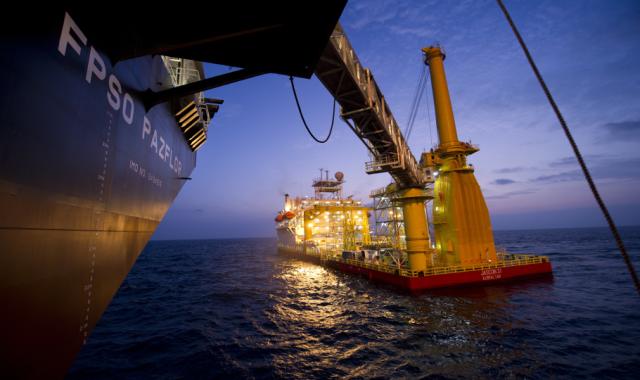
Total's deepwater FPSO Pazflor unit in Block 17 offshore Angola is bridge-linked to the Jascon 31 accommodation and construction vessel. (Source: Total)
The deepwater business has always been a long-term game for Total. Despite the latest lows being tested by the oil price, the operator’s deep offshore business remains one that it has reaffirmed it wants to and is continuing to grow.
Its share of global deep offshore production (in more than 500 m [1,640 ft] of water) will rise to 15% by 2017, it forecasts, with its own projects flowing from an average water depth of 1,200 m (3,937 ft). That production stream will be gathered by a total of nine FPSO units, two floating production units (FPUs), and between 450 and 500 subsea wells, representing a total capacity of 1.8 MMbbl/d of oil.
With the industry close but not yet producing in more than 3,000 m (9,843 ft) of water, the operator already is talking on the record about achieving field development activities in up to 4,000 m (13,124 ft) within the next 10 years.
4,000 m By 2025
Total has an outstanding pedigree, of course. It has pioneered some of the deepest projects in the world so far, including its flagship developments offshore Angola such as Girassol, Dalia, Pazflor and CLOV (Cravo, Lirio, Orquida and Violeta).
The operator’s head of technology innovation at Total E&P UK, Jeremy Cutler, pointed out at the SPE Offshore Europe Conference and Exhibition in Aberdeen recently that, “By the year 2020 a water depth of 3,000 m—from an oil development perspective—seems to be achievable. We see that by 2025 the expectation is that 4,000 m will be achieved.”
The company deems anything beyond 1,500 m (4,921 ft) as ultradeep water and has dubbed the new frontier beyond 3,000 m as simply “frontier deep water.” With more than 50% of its exploration portfolio in deep and ultradeep water, Total has a vested interest in R&D and enhancing new and existing deepwater production solutions. Cutler said simply that, “It will be very much a big part of our future and where much of our production revenue is going to come from.”
The current difficulty remains the high development costs associated with these types of technology-intensive projects, which make them hard to launch in the low oil price environment. But as a result, Total and the industry as a whole are being forced to study more ways to reduce costs.
“The challenge for us now, going forward, is how do we go deeper, longer—and cheaper?” he said. Cutler flagged up Total and also Royal Dutch Shell as leading the push to develop frontier deepwater areas, with the industry’s established group of majors as a whole generally holding by far the largest average areas in terms of frontier deepwater acreage.
Technology Gaps
Each new field brings its own technology challenge, Cutler said, and the current technology gaps for frontier deepwater facilities remain plentiful.
Some have been well-known for a while, such as the multiple flow assurance challenges related to transporting the hydrocarbons back to the surface facility “across what is clearly a wide pressure and temperature domain.” Cutler pointed out that below 600 m (1,969 ft) the water temperature is about -4 C (25 F), while at 1,500 m the hydrostatic pressure is 150 bar.
Other frontier deepwater gaps to be further researched and qualified include pipelay techniques and riser installation and maintenance, the mooring of FPSO units, subsea power distribution and water injection, seabed separation, multiphase pumps, and electric submersible pumps (qualified up to 6,000 m [19,685 ft] in wells).
Tieback Limits
According to Cutler, these will all help the industry on its mission to increase the length of step-outs and tiebacks, especially for oil, which currently stands at about 70 km (43 miles) at relatively shallow-water depths.
In deep water, the benchmark figure so far has been set by Murphy Oil with its Dalmatian South tieback in nearly 2,000 m (6,562 ft) of water in the Gulf of Mexico (GoM), reaching more than 40 km (25 miles) to the Petronius compliant tower platform in shallower waters. There are deeper tiebacks than this, of course, but the distance reduces accordingly. For example, Petrobras’s Cascade Chinook oil and gas project in more than 2,500 m (8,202 ft) of water in the GoM has subsea tiebacks but of less than 25 km (15.5 miles) in length.
For gas, Cutler added, “it’s a little bit different, with the step-outs already longer.” Total’s own prospective Tobermory subsea gas tieback, for example, will be nearly 180 km (112 miles) in length, in a water depth of more than 1,500 m, if the discovery does proceed to final sanction and development.
Subsea-to-beach
According to Cutler, Total is on a similar path as Statoil, with a serious long-term ambition to establish a subsea factory solution. “Eventually we want to remove the floater from the equation and go subsea-to-beach,” he said. “We have in our R&D program a number of different projects related to the so-called subsea factory concept.”
Multiphase production results in a high back pressure at the wellhead and the loss of potential deepwater reserves. So subsea processing segments such as the separation of gas and liquids and pressure boosting technologies will be required, he stressed. At present, 3,000 m or more “looks to be achievable with existing technologies, but not for subsea compression,” he commented.
Laggan-Tormore Reality
Total’s subsea-to-beach vision already has become reality. The company’s deepwater Laggan-Tormore gas-condensate field West of Shetland offshore the U.K. has been in the development phase for several years, but the field became operational early in February 2016.
The frontier project in 600 m of water is enabling an 18.8-MMcm/d (665-MMcf/d and 90 Mboe/d) gas export route from the area, with Cutler admitting Laggan-Tormore has been “a challenging project for us” but one that has been “a good test of subsea-to-beach.” The subsea-to-beach development is the first of its kind in the U.K. offshore sector and consists of a 143-km (89-mile) tieback of four initial subsea wells to a new onshore gas plant on the Shetland Islands with a capacity of 14 MMcm/d (500 MMcf/d). The nearby Edradour and Glenlivet discoveries will be developed in the next development phase.
Following treatment at the plant, the gas is being exported to the mainland via the Shetland Island Regional Gas Export System, while the condensates are exported via the Sullom Voe Terminal. Total E&P UK operates Laggan-Tormore with a 60% interest with DONG E&P (UK) Ltd. (20%) and SSE E&P UK Ltd. (20%).
FPSO, Subsea Solutions
Cutler also went on to highlight the work that Total has previously done on some of its biggest recent developments offshore Angola, where the use of FPUs in combination with innovative subsea technologies has enabled FPSO units to be a vital building block in the company’s development portfolio.
In particular, he flagged up Total’s CLOV project in 1,400 m (4,593 ft) of water, which came onstream mid-2014 and where it employed helico axial subsea multiphase pumps for the first time—a technology it sees as crucial for improving reservoir recovery rates. “This was essentially four field developments in one and made four uneconomic fields economic. We used a standard building block—the FPSO unit—but used it very flexibly. It was the subsea side of it and the reservoir systems that were the biggest challenge,” he said.
Cutler also highlighted the Pazflor development, where the company developed both light (Oligocene) and heavy (Miocene) oil reservoirs using a combination of bottom riser gas lift, three 1,000-tonne subsea separation units and six multiphase pumps—an industry first for two-phase separation and liquid boosting at the mud line. These pump the oil and gas to what was the world’s largest FPSO unit when Pazflor first started flowing in 2011.
Asked at the Offshore Europe Conference how the industry can prove the business case for subsea processing projects going forward, Cutler concluded that the industry had to “simply work harder” to get around the problems. “These deepwater fields are bigger, which really helps the economics. However, the oil price is making us work that much harder to get a solution that works.”
Recommended Reading
CorEnergy Infrastructure to Reorganize in Pre-packaged Bankruptcy
2024-02-26 - CorEnergy, coming off a January sale of its MoGas and Omega pipeline and gathering systems, filed for bankruptcy protect after reaching an agreement with most of its debtors.
From Restructuring to Reinvention, Weatherford Upbeat on Upcycle
2024-02-11 - Weatherford CEO Girish Saligram charts course for growth as the company looks to enter the third year of what appears to be a long upcycle.
Kimmeridge Fast Forwards on SilverBow with Takeover Bid
2024-03-13 - Investment firm Kimmeridge Energy Management, which first asked for additional SilverBow Resources board seats, has followed up with a buyout offer. A deal would make a nearly 1 Bcfe/d Eagle Ford pureplay.
Laredo Oil Subsidiary, Erehwon Enter Into Drilling Agreement with Texakoma
2024-03-14 - The agreement with Lustre Oil and Erehwon Oil & Gas would allow Texakoma to participate in the development of 7,375 net acres of mineral rights in Valley County, Montana.
SLB’s ChampionX Acquisition Key to Production Recovery Market
2024-04-21 - During a quarterly earnings call, SLB CEO Olivier Le Peuch highlighted the production recovery market as a key part of the company’s growth strategy.





